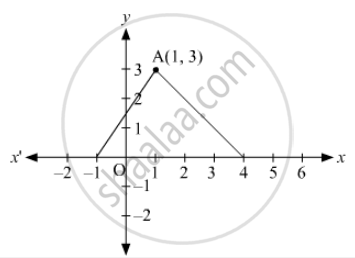Advertisements
Advertisements
प्रश्न
Show that the following points are the vertices of a square:
A (6,2), B(2,1), C(1,5) and D(5,6)
उत्तर
The given points are A (6,2), B(2,1), C(1,5) and D(5,6)
`AB = sqrt((2-6)^2 +(1-2)^2) = sqrt((-4)^2 +(-1)^2) = sqrt(16+1) = sqrt(17) units`
`BC = sqrt((1-2)^2 +(5-1)^2) = sqrt((-1)^2 +(-4)^2) = sqrt(1+16) = sqrt(17) units`
`CD = sqrt((5-1)^2 +(6-5)^2) = sqrt ((4)^2+(1)^2) = sqrt(16+1) = sqrt(17) units`
`DA = sqrt((5-6)^2 +(6-2)^2 )= sqrt((1)^2 +(4)^2) = sqrt(1+16) = sqrt(17) units`
Therefore, AB =BC =CD =DA = 17 units
Also, `AC = sqrt((1-6)^2 +(5-2)^2 ) = sqrt((-5)^2 +(3)^2) = sqrt(25+9) = sqrt(34) units`
`BD = sqrt((5-2)^2 +(6-1)^2) = sqrt((3)^2+(5)^2) = sqrt(9+25) = sqrt(34) units`
Thus, diagonal AC = diagonal BD
Therefore, the given points from a square.
APPEARS IN
संबंधित प्रश्न
If two opposite vertices of a square are (5, 4) and (1, −6), find the coordinates of its remaining two vertices.
Find the equation of the perpendicular bisector of the line segment joining points (7, 1) and (3,5).
Determine the ratio in which the straight line x - y - 2 = 0 divides the line segment
joining (3, -1) and (8, 9).
Find the points on the x-axis, each of which is at a distance of 10 units from the point A(11, –8).
`"Find the ratio in which the poin "p (3/4 , 5/12) " divides the line segment joining the points "A (1/2,3/2) and B (2,-5).`
Prove that the diagonals of a rectangle ABCD with vertices A(2,-1), B(5,-1) C(5,6) and D(2,6) are equal and bisect each other
The abscissa of a point is positive in the
Show that ΔABC, where A(–2, 0), B(2, 0), C(0, 2) and ΔPQR where P(–4, 0), Q(4, 0), R(0, 2) are similar triangles.
If the points A(−1, −4), B(b, c) and C(5, −1) are collinear and 2b + c = 4, find the values of b and c.
If P (x, 6) is the mid-point of the line segment joining A (6, 5) and B (4, y), find y.
The ratio in which (4, 5) divides the join of (2, 3) and (7, 8) is
If the points P (x, y) is equidistant from A (5, 1) and B (−1, 5), then
The coordinates of the fourth vertex of the rectangle formed by the points (0, 0), (2, 0), (0, 3) are
In Fig. 14.46, the area of ΔABC (in square units) is

Any point on the line y = x is of the form ______.
Find the point on the y-axis which is equidistant from the points (S, - 2) and (- 3, 2).
Point (3, 0) lies in the first quadrant.
In which ratio the y-axis divides the line segment joining the points (5, – 6) and (–1, – 4)?
The distance of the point (–1, 7) from x-axis is ______.
